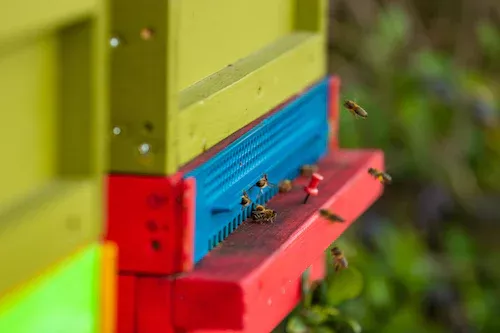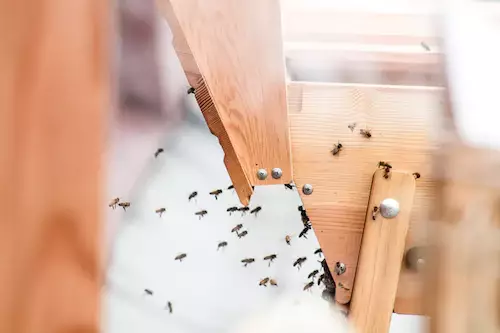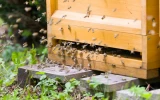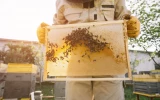When To Use or Remove a Beehive Entrance Reducer
A beehive entrance reducer is a great tool for helping manage the size of a beehive's entrance. Learn when to use or remove a beehive entrance reducer—a valuable tool to manage hive temperature, ventilation, and pest control.
A bee hive entrance reducer should be used when a hive is too active or when there are too many bees for the hive to sustain, particularly when the hive is weaker. It should be removed when the hive is strong and healthy, as it can limit the hive's ability to cool itself during hot weather.
To maintain a healthy hive and keep your bees happy, find out the best times to use a beehive entrance reducer, when to take it out, and the benefits of doing so.
Summary
- A beehive entrance reducer is an effective tool to regulate the size of the beehive's entrance.
- A beehive entrance reducer is used when the hive is starting to build up the bee population.
- You should remove a beehive entrance reducer when the bees are active in foraging and bringing pollen and nectar.

On this page:
When To Use A Beehive Entrance Reducer
A beehive entrance reducer is typically used in the early spring, when the hive is just starting to build up its population. By reducing the entrance size, the hive can better regulate the temperature and humidity of the hive, and can also help protect the hive from predators. Additionally, by reducing the entrance size, the guard bees can more easily protect the hive from invaders.
Installing A Beehive Entrance Reducer
Installing a beehive entrance reducer is an important step in beekeeping. Here are the simple steps to take when putting up the reducer:
-
Gather all the necessary materials needed for the installation, such as a bee hive entrance reducer, beekeeping gloves, a bee veil, a bee smoker, and a bee brush.
-
Put on the beekeeping gloves and the bee veil for protection.
-
Light the bee smoker and blow smoke into the beehive entrance to calm the bees.
-
Gently brush away any bees that are at the entrance of the hive.
-
Place the entrance reducer at the entrance of the hive and secure it with nails or screws.
-
The reducer should be placed approximately 1 to 2 inches from the bottom of the hive entrance, allowing just enough space for the bees to enter and exit the hive.
-
Use a hammer to drive the nails or screws into the wood of the hive.
-
Use a hammer to drive the nails or screws into the wood of the hive.
-
Give the hive a few puffs of smoke to help the bees adjust to the new entrance size.
When installing a beehive entrance reducer, it is important to make sure that it is securely fastened to the hive and that the entrance is not blocked or obstructed.

When to Remove A Beehive Entrance Reducer
Generally speaking, it should be removed during the spring months, when the bees are actively foraging and bringing in pollen and nectar. This is because the bees need more room to enter and exit the hive, and a reducer can limit the number of bees that can enter the hive. Additionally, the reducer can limit the amount of ventilation the hive gets, and this can cause the interior of the hive to become too hot or too humid.
It is important to note, however, that some beekeepers may choose to use the reducer year-round, as it can help protect the hive from predators. In this case, the reducer should be removed before the start of the honey flow and then replaced once the flow is over. This will help ensure that the hive has enough space to bring in enough nectar and pollen to produce a good honey crop.
Removing a Beehive Entrance Reducer
Removing a beehive entrance reducer is a simple process that can be done with a few basic tools.
-
Put on protective clothing and a beekeeping hat and veil. Make sure that you are well-protected before you attempt to remove the beehive entrance reducer.
-
Locate the entrance reducer at the bottom of the beehive.
-
Carefully brush the bees away from the entrance reducer and the hive entrance.
-
Gently grasp the entrance reducer with a pair of pliers and pull it away from the hive entrance.
-
If the entrance reducer is stuck, use a warm, damp cloth to soften the wax and make it easier to remove.
-
Once the entrance reducer is removed, inspect the entrance for any damage or obstruction.
-
Clean the entrance reducer with a damp cloth and inspect it for any damage.
-
Replace the entrance reducer if necessary.
-
Put the entrance reducer back in the hive and ensure that it is securely fastened.
-
Monitor the hive for any changes or problems, and make sure the bees are using the entrance reducer correctly.
What Exactly is a Beehive Entrance Reducer
A beehive entrance reducer is a device used to regulate the size of a beehive entrance. The device is typically a piece of wood or plastic that fits over the entrance.
The reducer allows the bees to control the flow of air in and out of the hive as well as the size of the opening to prevent intruders from entering and reduce the amount of heat lost from the hive. The reducer also helps to protect the hive from extreme weather conditions by preventing wind, rain, and other elements from entering the hive.

The Importance of A Beehive Entrance Reducer
Beehive entrance reducers are an essential piece of beekeeping equipment, as they help to protect the hive from external threats such as predators, thieves, and weather. By reducing the size of the hive entrance, the bees can better protect themselves from potential predators and thieves.
In addition, the reducer also helps to regulate the temperature of the hive by limiting the amount of air that can enter the hive. This helps protect the hive from drastic and sudden temperature shifts. The entrance reducer is also important in time, as it helps bees better regulate their population.
By limiting the size of the entrance, the number of bees that can enter or leave the hive is restricted. This prevents overcrowding in the hive, which can lead to disease and death. It also helps to ensure that the bee population is productive, as they are better able to regulate the resources within the hive and produce enough honey to sustain the colony.
The removal of a beehive entrance reducer is important for many reasons. One of the most important reasons is to ensure the health of the colony. A beehive entrance reducer is a device that blocks the entrance to the hive, reducing the size of the opening. This is often done during the winter months, when the bees don't need as much ventilation or space to fly in and out of the hive.
The size of the entrance should be adjusted as the seasons change and the size of the colony fluctuates. By late spring and summer, the colony should be large enough that the entrance needs to be opened up for increased ventilation and space for the bees to come and go.
If the entrance reducer isn't removed in time, the bees could become overheated and die from a lack of airflow. Another reason for removing the entrance reducer is to prevent pests from entering the hive.
In the winter, the entrance reducer can keep out mice, rats, and other pests that could damage the hive. However, if the entrance reducer isn't removed in time, pests could enter the hive and wreak havoc on the colony.

